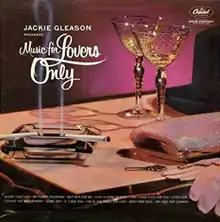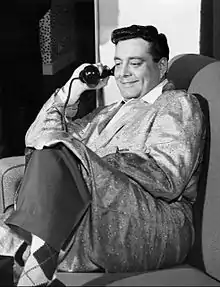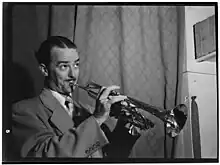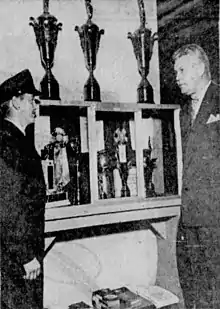| Music for Lovers Only | ||||
|---|---|---|---|---|
 | ||||
| Studio album by | ||||
| Released | October 27, 1952 | |||
| Genre | Easy-listening | |||
| Label | Capitol Records | |||
| Producer | Richard Jones | |||
| Jackie Gleason chronology | ||||
| ||||
Music for Lovers Only (or Jackie Gleason Presents Music for Lovers Only) is a studio album of easy-listening music by Jackie Gleason, wherein he conducted an orchestra performing standards. It was released by Capitol Records on October 27, 1952,[1] as a 10-inch LP with eight songs. It was reissued as an EP in January 1953,[2] followed in 1955 by a 12-inch LP with eight additional songs.[3][4][5][6] The extent of Gleason's involvement with the album's creation has generated debate since its release.[7][8]
Background

In January 1952, Gleason, who was then the host of the DuMont Network's television program Cavalcade of Stars, was offered a three-year exclusive contract by CBS worth $6 million[9][10] (approximately $63 million in 2021). Gleason accepted and upon signing the contract, he took a two-week vacation[10] and announced that he would be leaving Cavalcade of Stars in June.[11] Immediately following his departure, he began to adapt the program into The Jackie Gleason Show for CBS. It was during this period that Gleason began his musical career. He assembled a 27-piece orchestra[12] and made a number of recordings with them, including the "Melancholy Serenade" that would become the theme song for The Jackie Gleason Show.[13]
Announcements of a forthcoming release of an LP of instrumental music conducted by Gleason, the first in a separate three-year contract for Capitol Records, were made in July 1952.[14][15][16] Gleason said in an interview that same month that he had already composed the music and designed the cover for Lover's Rhapsody, which followed the release of Music for Lovers Only.[17] He also said that he had been inspired by Bing Crosby to pursue artistic and merchandising opportunities outside of his main career as an actor, for which purposes he founded Jackie Gleason Enterprises.[18][19] Gleason called his musical team Music for Lovers Only, which he said indicated the kind of music they played.[13] His first album would subsequently bear the same name.[1]
Recording

Production
According to Gleason, he conceived the idea of an album of "slow and dreamy music" in 1941, but "couldn't get anyone interested in it at the time."[20] In 1942, Gleason was cast in an uncredited role in the film Orchestra Wives. On the set, he met Bobby Hackett, a member of the Glenn Miller Orchestra, who played himself in the film. Despite Hackett's dental problems that made it difficult for him to play his preferred instrument, the trumpet, Glenn Miller hired him as a personal favor. Impressed by Hackett's trumpet playing, Gleason expressed hope for a future musical collaboration. When preparation for Music for Lovers Only began in 1952, Gleason engaged Hackett to play solo trumpet.[21][3]

Record labels were skeptical of Gleason's musical efforts. He initially proposed Music for Lovers Only and other instrumental albums to American Decca, which rejected them. Gleason's manager, Bullets Durgom, then persuaded Capitol Records to pay an advance of $1,000 (approximately $10,400 in 2021) in exchange for promotion on The Jackie Gleason Show. They agreed on the condition that Gleason finance most of the production himself.[3][21] Because of Gleason's fame as a comedian and concern that the public would not take his musical work seriously, he took care to maintain seriousness in his conduct with his musicians[13] and in the design of the album's jacket cover.[20]
The recordings for Music for Lovers Only took place in New York City during the summer of 1952. According to Capitol, recordings of the master takes took two sessions of three hours each.[22]
Questions about authorship of arrangements
The precise nature of Gleason's role in the making of Music for Lovers Only has been a matter of speculation since its release.[23][7] Although the album credits him with having presented, selected, and conducted the music on the album, it also credits Pete King (as C. Dudley King, Jr.) and producer Richard Jones as arrangers.[24] The widespread public perception was that Gleason had either played a lead role as arranger,[25][26] or was taking credit for another's work.[27] In interviews, Gleason confirmed that his role in the production of the album went beyond selection and conducting, but also acknowledged King’s work as arranger and collaborator.[28][20]
Although Gleason had no formal musical training,[29] he could play trumpet, piano, and organ sufficiently well to convey his ideas to King.[7][28][27] "I pick the notes out on an organ," Gleason told the New York Daily News. "I have a way of marking them down so [King] can interpret them."[20] Gleason struggled to convey his ideas to professional musicians. Having no knowledge of musical terminology, he resorted to poetic metaphors which they found frustrating to understand.[30]
King said that despite Gleason's lack of musical education, his ability was "a little more than musicians credit him with and a little less than the public thinks he knows."[27] Hackett expressed contradictory opinions about Gleason's acumen, saying on one occasion that professional musicians were "always amazed" by him, while on another saying that his principal contribution to the recordings was that "he brought the checks."[3] Gordon Jenkins said Gleason's work consisted of "sit[ting] in the control room puffing a fat cigar while his arrangers do the conducting."[30]
Release
Music for Lovers Only was released on LP by Capitol Records on October 27, 1952,[1] followed by an EP in January 1953, one of Capitol's first four releases in that format.[2] In 1955, a 12-inch LP with eight additional songs was issued. A stereo remake with the same personnel was issued in 1958.[3] In 1957, Dick Haymes recorded a vocal cover of Gleason's song, "My Love for Carmen," accompanied by Gleason and his orchestra.[31]
Reception

Success
Music for Lovers Only was widely praised upon its release and became an enduring bestseller on both LP and EP,[32] reaching No. 1 on Billboard magazine's pop album chart and remaining in the Top 10 for 153 weeks.[33][34] In April 1953, Dorothy Kilgallen reported that the album had sold over 100,000 copies;[35] by June, it was the bestselling album yet in Capitol Records’ history.[36] In March 1954, Music for Lovers Only was joined by two later Gleason albums in the Billboard Top 10.[37][38] It was also one of the bestselling LPs in that format's first decade of existence.[39]
Hackett's solo trumpet performance drew much critical attention. Walter Winchell said that it set the album's "groove on fire."[40] Charles Menees in the St. Louis Post-Dispatch said that it was the album's "big attraction," adding that "Bobby Hackett With Strings" would have made for a suitable alternative name for it.[41] Avilda Peters called his playing "a thrilling sound which breaks through the orchestral arrangement of strings and reeds."[26]
Gleason's appearance as a musical arranger and conductor also elicited commentary and was well received. "Gleason doesn't over-orchestrate," said Peters. "He simply offers smooth, soft, candlelight-mood music that appeals to both young and old."[26] Tom E. Danson wrote that in Music for Lovers Only Gleason "prove[d] conclusively that he's as agile with the baton as in the humor department."[22] Doris E. Bynum in the Orlando Sentinel balked at the album's name, but called its arrangements "sheer heaven."[42]
Live performances
The success of Music for Lovers Only resulted in Gleason’s public debut as bandleader on February 12, 1953, at the La Vie en Rose nightclub in New York City, wherein he performed the music from the album in a program shared with Toni Arden. Gleason said he did it as a favor to his friend Monte Proser, the club's proprietor.[43][44] "Monte has this club that needs unusual attractions because he's keeping it out of the usual entertainment rut and he said he thought my band could do some business for him," Gleason said. "Monte's done some things for me in the past. I couldn't turn him down."[13] He later recalled that he found the experience of conducting an orchestra in person "tough" and, because of his inability to read music, was required to memorize 28 different arrangements.[20] Among those who attended Gleason's debut were Steve Allen, Milton Berle, Johnnie Ray, and Jackie Coogan.[45]
In March 1953, Gleason said that he was considering forming two Music for Lovers Only orchestras, led respectively by Hackett and Billy Butterfield, and sending them on tour.[20] Gleason participated in later live performances, joined by the entire cast of The Jackie Gleason Show, but delegated leadership of the orchestra to Sammy Spear, the show's bandleader.[46][47]
Legacy
Over 40 albums by Gleason followed the release of Music for Lovers Only.[7] It was an early example of a "theme album," referred to after the advent of rock music as a "concept album."[48] Its success also led to rival record labels issuing their own "Music for" albums, which were described by the New York Times as "music with a function, a sort of modern Gebrauchsmusik."[49]
Gleason evoked the sound of Music for Lovers Only in his final album, Romeo and Juliet: A Theme for Lovers, which was released in late 1969.[50][51]
Track listing
Original 1952 track listing
| No. | Title | Lyrics | Music | Length |
|---|---|---|---|---|
| 1. | "Alone Together" | Howard Dietz | Arthur Schwartz | 3:07 |
| 2. | "My Funny Valentine" | Lorenz Hart | Richard Rodgers | 3:23 |
| 3. | "But Not For Me" | Ira Gershwin | George Gershwin | 2:51 |
| 4. | "Love (Your Spell is Everywhere)" | Elsie Janis | Edmund Goulding | 2:43 |
| No. | Title | Lyrics | Music | Length |
|---|---|---|---|---|
| 1. | "I'm in the Mood for Love" | Dorothy Fields | Jimmy McHugh | 3:32 |
| 2. | "Love Is Here To Stay" | Ira Gershwin | George Gershwin | 3:24 |
| 3. | "I Only Have Eyes For You" | Harry Warren | Al Dubin | 3:21 |
| 4. | "Body and Soul" | Edward Heyman, Robert Sour, Frank Eyton | Johnny Green | 3:18 |
Expanded 1955 release listing
| No. | Title | Lyrics | Music | Length |
|---|---|---|---|---|
| 1. | "Alone Together" | Howard Dietz | Arthur Schwartz | 3:07 |
| 2. | "My Funny Valentine" | Lorenz Hart | Richard Rodgers | 3:23 |
| 3. | "But Not For Me" | Ira Gershwin | George Gershwin | 2:51 |
| 4. | "Love (Your Spell is Everywhere)" | Elsie Janis | Edmund Goulding | 2:43 |
| 5. | "I'm in the Mood for Love" | Dorothy Fields | Jimmy McHugh | 3:32 |
| 6. | "Love Is Here To Stay" | Ira Gershwin | George Gershwin | 3:24 |
| 7. | "I Only Have Eyes For You" | Harry Warren | Al Dubin | 3:21 |
| 8. | "Body and Soul" | Edward Heyman, Robert Sour, Frank Eyton | Johnny Green | 3:18 |
| No. | Title | Lyrics | Music | Length |
|---|---|---|---|---|
| 1. | "Little Girl" | Madeline Hyde | Francis Henry | 3:24 |
| 2. | "I Cover the Waterfront" | Johnny Green | Edward Heyman | 3:43 |
| 3. | "Some Day" | Brian Hooker | Rudolf Friml | 3:28 |
| 4. | "If I Had You" | Jimmy Campbell and Reg Connelly with Ted Shapiro | 3:32 | |
| 5. | "When a Woman Loves a Man" | Johnny Mercer | Gordon Jenkins, Bernard D. Hanighen | 2:28 |
| 6. | "A Stranger in Town" | Mort Greene | Leigh Harline | 2:46 |
| 7. | "A Moonlight Saving Time" | Irving Kahal | Harry Richman | 2:29 |
| 8. | "My Love for Carmen" | Jackie Gleason | 3:20 |
Personnel
- Richard Jones — producer, arranger
- Jackie Gleason — conductor, arranger, and composer (of "My Love for Carmen")
- Pete King (credited as C. Dudley King, Jr.) — arranger
- Bobby Hackett — trumpet
References
- 1 2 3 "MUSIC NOTES". Quad-City Times. Davenport, IA. October 19, 1952. Archived from the original on November 15, 2021. Retrieved November 15, 2021.
- 1 2 Stevens, Dale (January 11, 1953). "Kay Starr Is Back In The Limelight". Retrieved November 15, 2021.
And [Kay Starr's] album is but one of a group of four which will comprise Capitol's first Extended Play (EP) efforts. The others include Jackie Gleason's heralded Music for Lovers Only[...], a warm and appealing Jane Froman album, and eight tunes by one Dean Martin.
- 1 2 3 4 5 Anderson, Gordon (2017). Liner notes for the 2017 CD reissue of Music for Lovers Only. Real Gone Music.
- ↑ "Jackie Gleason - Music For Lovers Only". Discogs. Retrieved December 26, 2020.
- ↑ "Music For Lovers Only". AllMusic. Retrieved December 26, 2020.
- ↑ Back cover to "Music for Lovers Only".
- 1 2 3 4 Guerrieri, Matthew (February 24, 2016). "Jackie Gleason: Mood Music Tycoon". Boston Globe. Retrieved November 15, 2021.
- ↑ Lanza, Joseph (2004). "Chapter 8: The Moodiest Years on Record". Elevator Music: A Surreal History of Muzak, Easy-Listening, and Other Moodsong. Ann Arbor, MI: University of Michigan Press. p. 74. ISBN 0472089420.
- ↑ Pannitt, Merrill (January 2, 1952). "Screening TV: Kefauver Sessions Tops In '51 For Drama, News". Philadelphia Inquirer. Archived from the original on November 15, 2021. Retrieved November 15, 2021.
- 1 2 Wilson, Earl (January 4, 1952). "Jessel to Wed, Even Sets The Date; Gleason Collects". The State (South Carolina). Archived from the original on November 15, 2021. Retrieved November 15, 2021.
- ↑ O'Brian, Jack (January 11, 1952). "Art Carney Gets Chance While Gleason Vacations". Philadelphia Inquirer. Archived from the original on November 15, 2021. Retrieved November 15, 2021.
- ↑ Foster, Bob (March 3, 1953). "TV-Radio". San Mateo Times. San Mateo, CA. Retrieved November 16, 2021.
- 1 2 3 4 Gaver, Jack (February 23, 1953). "Jackie Goes 'Straight' As Band Leader". Dayton Daily News. Dayton, OH. Retrieved November 15, 2021.
- ↑ Adams, Cedric (July 5, 1952). "In This Corner". Minneapolis Star. Archived from the original on November 15, 2021. Retrieved November 15, 2021.
- ↑ Cullison, Art (July 7, 1952). "Audio and Video: All-Star Contest On Radio, TV". Akron Beach Journal. Akron, OH. Archived from the original on November 15, 2021. Retrieved November 15, 2021.
- ↑ Doudna, Bill (July 8, 1952). "Bill Doudna's Spotlight: Names In The News". Wisconsin State Journal. Madison, WI. Archived from the original on November 15, 2021. Retrieved November 15, 2021.
- ↑ Remenih, Anton (July 20, 1952). "Jackie No Snob; He Lampoons Rich And Poor". Chicago Tribune. Archived from the original on November 16, 2021. Retrieved November 15, 2021.
- ↑ Devane, James (July 29, 1952). "Look and Listen: Television Gets Radio Shows". Cincinnati Enquirer. Retrieved November 15, 2021.
- ↑ McCrary, Tex; Falkenburg, Jinx (September 14, 1952). "Tycoon Gleason Will Match Hopalong In Business World". Oakland Tribune. Retrieved November 15, 2021.
- 1 2 3 4 5 6 Gardella, Kay (March 3, 1953). "Televiewing and Listening In". Daily News (New York City). Retrieved November 15, 2021.
- 1 2 Lanza 2004, p. 75.
- 1 2 Danson, Tom E. (December 6, 1952). "TV-Radiologic: Jackie Gleason Album Big Surprise to Many". San Pedro News-Pilot. Retrieved November 15, 2021.
- ↑ Reynolds, Fred. "Platter Chatter". Chicago Tribune. Retrieved November 15, 2021.
Exactly what part TV Comic Jackie Gleason played in the Capitol album, 'Music for Lovers Only,' which bears his name, I do not know. What's more, I don't care.
- ↑ Reproduction of 1953 edition liner notes in 1998 CD reissue. Collector's Choice. 1998.
- ↑ "Record Roundup". Kenosha News. Kenosha, WI. April 16, 1954. Retrieved November 15, 2021.
- 1 2 3 Peters, Avilda (August 25, 1953). "Disk Data". Bristol Herald Courier. Bristol, TN. Retrieved November 16, 2021.
- 1 2 3 Beck, Roger (January 23, 1954). "Off The Records". Mirror News (Los Angeles). Retrieved November 15, 2021.
- 1 2 Wolters, Larry (March 13, 1955). "Jackie Gleason—Television's One-Man Gold Rush". Chicago Tribune Magazine. p. 49. Retrieved November 15, 2021.
- ↑ Coppola, Jo (May 28, 1953). "'And Away We Go' for a Day With Gleason". Newsday (Nassau). Hempstead, NY. Retrieved November 16, 2021.
Although he plays the trumpet and composes music. . . the comic 'never had a lesson in his life.'
- 1 2 Lanza 2004, p. 74.
- ↑ Lyons, Leonard (April 15, 1957). "The Lyons Den". The Morning Call (Allentown). Allentown, PN. Retrieved November 17, 2021.
- ↑ Bell, Larry (March 21, 1954). "Record Collector: No. 1 "Papa" Just Ain't Music". Orlando Sentinel. Retrieved November 16, 2021.
- ↑ "The Quick 10: 10 Billboard 200 Milestones". Mental Floss. April 23, 2009. Archived from the original on September 5, 2015. Retrieved August 17, 2015.
- ↑ "Top Album". Sunday News (Lancaster, PN). Lancaster, PN. July 4, 1965. Retrieved November 16, 2021.
- ↑ Kilgallen, Dorothy (April 15, 1953). "Voice of Broadway: Jackie Gleason's Big Gag Now Money In His Big Bag". Fort Worth Star-Telegram. Retrieved November 16, 2021.
- ↑ Battelle, Phyllis (June 23, 1953). "Assignment America... Gleason Imprisoned". Clarion-Ledger (Jackson). Jackson, MI. International News Service. Retrieved November 16, 2021.
- ↑ "Best Selling Popular Albums". The Billboard. March 27, 1954. p. 38.
- ↑ Watt, Douglas (March 28, 1954). "Let's Look at the Records". New York Daily News. Retrieved November 16, 2021.
- ↑ "Best-Selling LP's of Past Ten Years". New York Times. March 16, 1958. ProQuest 114624913. Retrieved November 16, 2021.
- ↑ Winchell, Walter (December 12, 1952). "Broadway And Elsewhere". Indianapolis Star. Indianapolis, IN. Hearst. Retrieved November 16, 2021.
- ↑ Menees, Charles (December 11, 1952). "Popular Recordings". St. Louis Post-Dispatch. Retrieved November 16, 2021.
- ↑ Bynum, Doris E. (March 15, 1953). "Record Collector's Corner". Orlando Sentinel. Orlando, FL. Retrieved November 16, 2021.
- ↑ Winchell, Walter (February 11, 1953). "Memos of a Midnighter". Wilkes-Barre Times Leader. Wilkes-Barre, PN. Hearst. Retrieved November 16, 2021.
- ↑ Kilgallen, Dorothy (January 10, 1953). "Voice of Broadway: Gossip in Gotham". The Gazette (Montreal). Retrieved November 16, 2021.
- ↑ "Say La Vie!". New York Daily News. February 16, 1953. Retrieved November 16, 2021.
- ↑ "Gleason And Cast Sign For 2-Week Stage Run In N. Y." Democrat and Times. November 7, 1954. Retrieved November 16, 2021.
- ↑ "Gleason's Band". New York Daily News. November 2, 1954. Retrieved November 16, 2021.
- ↑ Keightly, Keir (Autumn 2008). "Music for Middlebrows: Defining the Easy-Listening Era, 1946–1966". American Music. 26 (3): 319. JSTOR 40071710. Retrieved November 16, 2021.
- ↑ Lawrence, Harold (November 21, 1954). "What You Will: 'Music For' Disks Give Anything You Want". New York Times. ProQuest 113054318. Retrieved November 16, 2021.
- ↑ Johnston, Vance (December 7, 1969). "Records: Gleason Does It Again!". Tampa Tribune. Retrieved November 16, 2021.
- ↑ Zacheis, Leo (December 28, 1969). "New Records in Review". Cedar Rapids Gazette. Retrieved November 16, 2021.